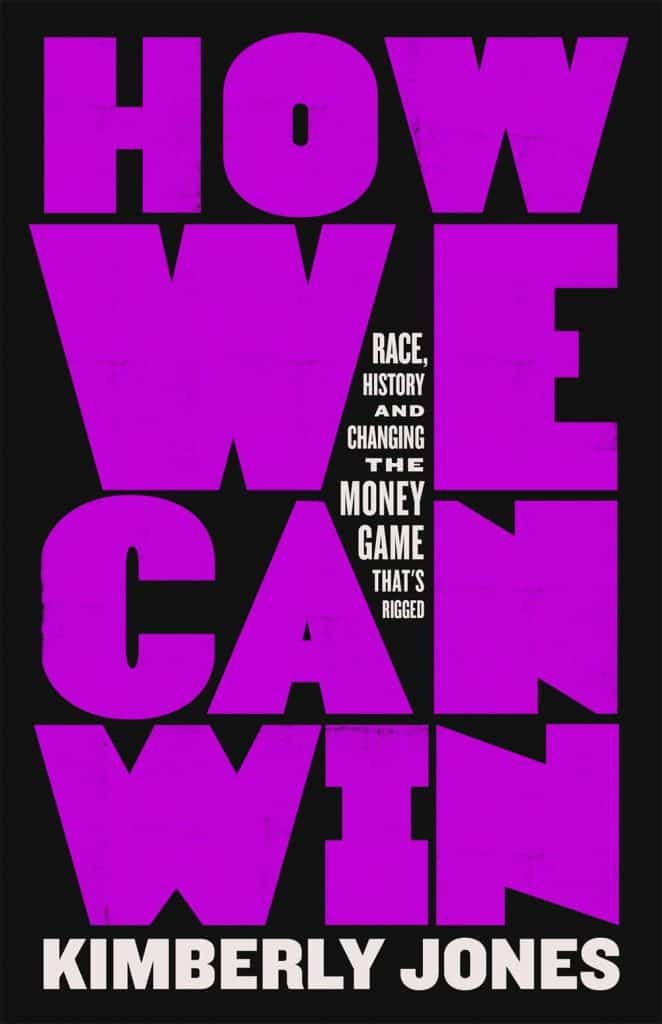Title: How We Can Win: Race, History, and Changing the Money Game That’s Rigged
Author: Kimberly Jones
Publisher: New York: Henry Holt and Company, 2022
Pages: 192 pages
Reviewer: Jason Rowland
Kimberly Jones’s fierce dedication to seeing people of color play offense for a change in the money game of our nation is compelling and attractive in her new book, How We Can Win: Race, History, and Changing the Money Game That’s Rigged. In addition, her residency and love for our mutual city, Atlanta, were evident in her writing. For 28 years, I have pastored in urban settings in the South. This book resonated with me because as a Caucasian pastor to people of color, a husband to a woman of color, and a father to children of color, I seek resources and avenues to equip those around me spiritually, financially, emotionally, and mentally.
Jones is a writer, host of the Atlanta chapter of the Well-Read Black Girl book club, and an activist. She has directed diverse web series and feature films and has a deal with Warner Brothers Pictures. Jones is also co-author of the bestselling young adult novels, I’m Not Dying with You Tonight and Why We Fly,1 which became a National Association of the Advancement of Color People Image Award finalist.
In 2020, Jones, who currently resides in Atlanta, was interviewing protesters protesting the death of George Floyd. She recorded a video about racism that went viral online. Jones uses an analogy of the board game Monopoly in the seven-minute video to explain the history of racism and its consequence on black Americans. This video, seen over two million times on YouTube and shared by celebrities such as Madonna, LeBron James, and Trevor Noah, led to her writing How We Can Win.
In her book, Jones shares the story of her volunteering for an at-risk girls’ organization whose goal was to teach them leadership and gain confidence. She taught them economics and finances, where they played Monopoly.
Monopoly, originally called the Landlord’s Game, was created by Elizabeth Magie in 1904. Its original intent was to teach people how land builds in value and why some are more expensive than others. Magie desired to display the unfairness created when people create monopolies.
One day, as Jones was using Monopoly to teach the girls about building wealth, one of the young girls missed her turn. Though she was doing very well, the young girl could not catch up. Her missed turn led her to a downfall for the rest of the game. This instance illuminated to Jones that this Monopoly metaphor is what it has been like to be Black in America. One missed turn, and one loses so much ground.
Her viral video became the premise of the book. Her protest declared if she decided that she wanted to play Monopoly with someone for four hundred years, she would not allow the other to have any money, or she would not allow them to have anything on the board that would enable the other person to ever win. They play for fifty rounds, and everything the person gained and earned while playing that round of Monopoly was taken. She compared that to Tulsa, Rosewood, and other places of historical Black economic wealth.
She continued to state how Blacks were self-sufficient, owned stores, owned property, and how they were burned to the ground. She shared how no one can win the game. The game is fixed, and society is lucky that what Black people are looking for is not revenge but equality.
Jones incredibly weaves the history of racial economic injustice, her story, and financial literacy into one book. In one chapter, “Reconstruction,” she delves into its history and effect on Black America. She covers Black Codes, the Southern state’s response to the emancipation of formerly enslaved people, making it a crime for one to not work for a white person creating cheap labor. She tells of Jim Crow and how, for two hundred years, an equivalent of the game of Monopoly was being played on the bodies of Blacks. Altogether, she explains how the playing field for Black Americans has never been level, leading to her next chapter, “The Game is Fixed.”
Jones begins it with three sentences that sum up the Black American experience up to the Civil Rights movement, “Slavery is how we got here. Reconstruction was our brief moment in the sun. Jim Crow was America showing us how they really feel about us, and the Civil Rights Movement was the way we proved to ourselves that we could save our own lives.”2 Throughout, she chronicles atrocities since the Civil Rights movement, including policing Black people, which Jones labels as the grandchild of slave catching.3 Jones continues with the loophole in the Thirteenth Amendment allowing any Black person accused of a crime into free service (slavery) via mass incarcerations. Furthermore, she narrates how the War on Drugs contributed to the mass incarceration of Black individuals at a disproportionate disadvantage to white counterparts.
As an already established young adult author, a young person rides along with Jones in the chapter, “Hood Girls Can Be Heroes Too,” as she shares stories of being Black and raised in the South Side of Chicago. She witnessed her first murder at fifteen yet respected the hood in providing her with many aptitudes she uses today. She continues by describing the gang life among her friends, school, moving to Atlanta, falling on hard times, and receiving government assistance. Jones then writes about her job at the bookstore, Little Shop of Stories, which she contributes to her writing success. A short line speaks volumes in the chapter: “It’s expensive to be broke.”4 (That one line, if wholly comprehended, should implore community, church, and family leaders to guide their followers to more significant financial literacy.)
The chapter “Nine Priorities for a Balanced Life” can be extracted by itself and used for teens and young adults as a guide for life and financial literacy. It consists of plentiful information about career, home, transportation, and relationships. It continues by covering finances, health and beauty, hobby, education, and community. These topics could assist any young adult or teen embarking on adulthood with issues they will face. Furthermore, the information would educate foster children aging out of the system with an elementary education of essential life skills and knowledge.
How does Jones say people of color can begin winning? She is a proponent of slave reparations to descendants of formerly enslaved people. Jones shares that the receipts are there for what America has made on the backs of Black people, “pimping our labor, stealing our resources, and cultural capital, killing us.”5 Jones concludes that the board game needs to change, requiring what she calls a Reconstruction 2.0.
Like her viral video, Jones’ book uses her platform as a call to action through the chapter, “Reconstruction 2.0,” for Black people to better themselves financially both individually and as a whole. Jones defines what the government can do for Black America. She shares the country’s need for a peaceful process for equity through a truth and reconciliation commission which was successful in South Africa after apartheid. Next is to dismantle old, entrenched systems which have marginalized, impoverished, and kept Black Americans out of equal participation in the American economy. Reinstituting and reestablishing the Freedman’s Bureau is important to Jones. Its original intent was to help millions of formerly enslaved Black people in the South after the Civil War. She goes further to share her ideas on how the government can address police, neighborhoods, minimum wage, civil rights, doctors, and teachers. She concludes the chapter with a charge for the Black community to buy Black, self-educate, vote, and ensure one’s community and personal life are healthy.
Jones does not close her book without hope. Despite all of this, she feels hopeful that our country is headed to a happier, healthier America. The civil unrest of 2020 proved to her that Black Americans are not alone. Further, she shares that her real ambition is to complete life as a sage, old, proud Black lady in leather slippers and a flowered housecoat, cooling herself with an MLK church fan while sharing centuries of old wisdom via stories, catchphrases, expressions, and sayings. Proudly, Jones’s sage advice is here today in the pages of her book.
If the publishers were considering a reprint of this book, one recommendation would be to include citations. The book has a plethora of astounding historical and economic data. Sadly, however, there are no citations to back up such claims. Thus, the information can be difficult to use for professional purposes. Some data is so surprising it would cause one to question the data and its accuracy. Despite the lack of citations, I infer from the author that her intent was not for her work to be used by professionals or those in the upper echelons of academia but by the next generation–teens and young adults–who could take her book and apply it to their lives.
For many Caucasian readers, Jones’s writing can be hard to consume. It takes an uncompromising look at America’s past and makes the reader consume its repugnant taste. “Truthfully raw” is one way to describe the book, yet one turns the page, and Jones’s motherly wisdom and advice pours out to the next generation. Jones will not allow her reader to wear rose-colored glasses.
Jones wrote the book for Black America, yet its content is invaluable for all. Overall, Jones’s work is solid for urban leaders for their missional and personal use. Its use is beneficial to educate teens, inspire young adults, and provide all with the history of economic unfairness while equipping for a better financial future for all. Unless one knows where one came from, one cannot go forward. The book is her treasurable knowledge she uses as a gift to pass on to other people of color like my children, to whom I, as a father, plan to also pass along.
Notes
1 Jones, K. and G. Segal, Why We Fly (Naperville, IL: Sourcebooks, Inc., 2021); and G. Segal, K. L. Jones, and K. Jones, I’m Not Dying with You Tonight (Naperville, IL: Sourcebooks, Inc., 2019).
2 Page 46.
3 Page 50.
4 Page 22.
5 Page 61.


1 thought on “Review: How We Can Win: Race, History, and Changing the Money Game That’s Rigged”
Great View Jason!!!